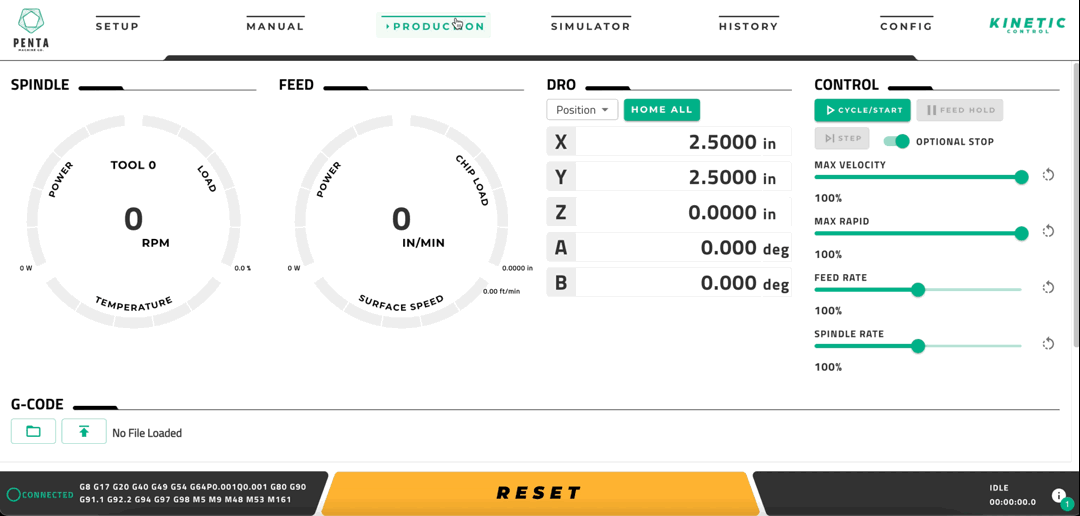New Feature! Simulator built into Kinetic Control
Back in November of 2018 we released the Pocket NC machine simulator. Since then, we have gotten great feedback on its usefulness and improvement to the workflow of making parts on the Pocket NC V2 machines.
Then, in November of 2021, we released our new control software and user interface, Kinetic Control. This upgrade gave us the base structure on which many more improvements and features have been, and can be, built upon.
One of the major features we had our sights set on was embedding the Pocket NC simulator into the Kinetic Control user interface. We knew this would greatly enhance the user experience of both the simulator and the Pocket NC machine. A couple of months ago we made that goal a reality and now, with Kinetic Control version 5.5.0 or higher, users can simulate their g-code within the Kinetic Control interface.
The combination of Kinetic Control and the simulator is one of those situations where the whole is greater than the sum of its parts, so here are some of the top benefits users will get with this new feature.
Automatic Simulation
With the simulator integrated into the Kinetic Control UI, there is no longer a need for users to upload their g-code to two separate places. When g-code is uploaded to Kinetic Control and selected as the active program, it is automatically simulated in the background so that when a user navigates to the Simulator page, the simulation has processed and is ready to view.
This streamlines the workflow of making a part on the Pocket NC significantly because it removes a whole step completely. This advantage really shows when changes to machine setup or the program have to be made.
Sync’d Offsets
In order to get as accurate of a simulation as possible it is important to provide the simulator with the same information the machine will be using to execute a g-code program. This typically requires not only the step of obtaining the information, but also transferring it to the simulator.
Since the Simulator within Kinetic Control is tied directly to the machine and UI, it can now automatically sync with user-defined offsets like TLO (tool length offset) and Work Offsets. This goes a long way in improving workflow as it removes the step of transferring information to the simulator, which speeds up machine setup and reduces the chances of introducing human error.
Existing TLO and Work offsets are automatically used upon uploading and selecting a g-code program. Then, as users define offsets based on the specifics of their project, the simulation is updated to reflect those changes.
Mirror Mode
Mirror mode is completely new to the Pocket NC simulator and is only available within Kinetic Control. When the machine is running a g-code program and actually cutting a part, this mode allows users to mirror the machine’s movements to the simulator.
The use of mirror mode can be beneficial in a variety of situations, however the most notable is the ability to help users proof a program that has never been run before. With the ability to look ahead by defining how many lines of code to plot, users can see potential problems that may result in a crash, broken tool, scrapped part, etc. This, of course, allows users to pause the machine well ahead of any potential problems and determine whether the program needs to be aborted or not.
Putting the simulator in Mirror mode also allows users access to the Control pane, which provides the ability to start, pause and step through the g-code program. The machine overrides are also available so that users can change speed and feed values ahead of a particularly questionable section of an unproven g-code program.
Mirror mode allows users to be proactive instead of reactive when it comes to running g-code that has never been proven before.
Foundation for future 3D interactions
The integration of the simulator into the Kinetic Control user interface is an exciting step towards being able to offer additional, more advanced 3D interaction features in the future.
We have a lot of ideas on what else could be done using the simulator as a base. And while many of those ideas are far from being released, we can pretty confidently say that they will bring the ease of machining on Penta machines up to a whole new level!
As you use the simulator inside Kinetic Control, let us know what you think of it and how it could be improved! We love feedback on our products, it helps us make them better for current and future users.
If you have any feedback or questions about Kinetic Control, the simulator, or the Pocket NC in general, please feel free to contact us at service@pentamachine.com, we are here to help!




